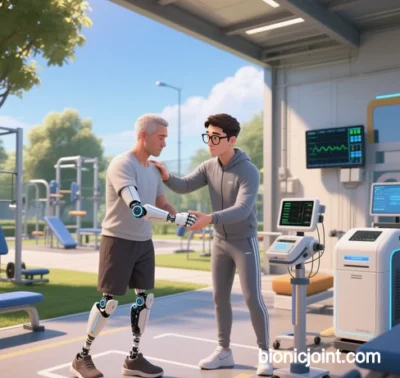
Breakthroughs in Bionic Joints for Healthcare and Robotics
Bionic joints, emerging from the convergence of biomechanics, materials science, AI, and robotics, are redefining the boundaries of healthcare and intelligent machines. Their transformative impact extends beyond technical improvements, driving paradigm shifts in two key domains:
- Healthcare: Transitioning from “repairing damage” to “functional enhancement,” enabling precise orthopedic treatments, intelligent rehabilitation, and lifelong health management.
- Robotics: Evolving from “rigid execution” to “adaptive flexibility,” granting robots human-like mobility, environmental awareness, and self-healing capabilities.
Below is an in-depth analysis across four dimensions: technological breakthroughs, applications, interdisciplinary integration, and future directions.
I. Technological Breakthroughs: From Structural Mimicry to Intelligent Synergy
Smart Surgical Navigation and Precision Orthopedics
- Robot-Assisted Joint Replacement: Systems like Stryker’s MAKO adjust bone-cutting parameters in real time via force feedback, improving bone retention by 15% and reducing postoperative complications by 20%. China’s “Honghu” knee replacement robot achieves submillimeter precision, elevating postoperative Harris Scores by 25%.
- Multimodal Data Integration: Jilin University’s 3D-printed smart prosthetics combine patient-specific bone mapping and bioinspired interfaces to address large-scale bone defects, leading global clinical validation efforts.
Bioinspired Materials and Interface Optimization
- Cartilage-Mimetic Coatings: Polyvinyl alcohol hydrogel (PVA-H) replicates natural cartilage microstructure, paired with nano-hyaluronic acid coatings to reduce artificial joint friction by 40% and extend lifespan to 20 years.
- Self-Healing and Sensing: CVTE’s patented bionic knee exoskeleton uses flexible cables and embedded micro-sensors to monitor stress distribution, alerting to loosening risks while enabling active rotation.
Neural Interfaces and Dynamic Control
- Brain-Machine-Joint Loop: The Italian Institute of Technology’s Natural BionicS project connects prosthetic limbs to spinal nerves for intuitive motion decoding, raising grip success rates from 70% to 89%. Fraunhofer IPA’s EMG sensor band enables millisecond prosthetic responses with 92% gait naturalness.
II. Applications: Reshaping Clinical and Industrial Paradigms
Healthcare Innovations
- Personalized Rehabilitation: MIT’s variable-stiffness knee exoskeleton reduces amputees’ walking energy expenditure by 18% and enhances slope-climbing ability by 40%. Xiaomi’s humanoid robots optimize rehab training fluidity, cutting energy consumption by 30%.
- Disease Prevention: Bionic joint implants with IL-6 biosensors transmit infection alerts via Bluetooth, reducing revision surgeries by 30%.
Robotics Advancements
- High-Dynamic Motion Control: Oxford University’s bionic elbow replicates 98.8% of biological joint mobility, tripling torque capacity for quadruped robots on rough terrain. Techman Robot’s DJB joint module achieves a 110N·m/kg torque-to-weight ratio, enabling humanoid robots to sprint at 5Hz.
- Precision Surgery: The Da Vinci system’s bionic wrist improves suturing accuracy to ±0.05mm, slashing vascular complication risks by 60%.
III. Interdisciplinary Synergy: Collaboration and Ethical Challenges
AI and Quantum Computing
- Generative Design: Tools like CO-BERTa optimize protein sequences, boosting expression by 50%. Quantum annealing resolves multi-parameter optimization, extending prosthetic fatigue life to 20 years.
- Federated Learning: The H3Africa initiative uses blockchain for cross-border medical data collaboration while ensuring GDPR compliance.
Ethical and Regulatory Considerations
- Dynamic Certification: China’s NMPA mandates biannual clinical performance updates for surgical robots to ensure safety.
- Equity Challenges: High costs exacerbate healthcare disparities, necessitating open-source platforms like Galaxy Project to democratize access.
IV. Future Directions: From Functional Replacement to Life Augmentation
Biological Integration and Tissue Engineering
- 3D Bioprinted Joints: Patient-derived stem cells and collagen scaffolds create vascularized bone-cartilage composites with 80% vascularization, avoiding immune rejection.
- Gene-Enhanced Lubrication: CRISPR-edited synovial cells overexpress PRG4, improving lubrication by 50% and cutting wear rates to 1/5 of traditional materials.
Consciousness and Cross-Species Innovation
- Neuroplasticity-Driven Rehab: Closed-loop electrical stimulation rebuilds motor memory in spinal injury patients, tripling exoskeleton rehab efficiency.
- Insect-Inspired Design: Grasshopper joint mechanics inspire disaster rescue robots with 200% leap efficiency gains.
Conclusion: Defining a New Era of Human-Machine Symbiosis
Bionic joints herald transformative shifts in both fields:
- Healthcare: Elevating from disease treatment to human enhancement via AI and biological fusion.
- Robotics: Transitioning tools into lifelike entities capable of environmental adaptation and energy autonomy.
As consciousness interfaces and quantum biocomputing mature, bionic joints will evolve into hyper-personalized life components—dynamically customizable in mechanics, metabolism, and aesthetics—ushering in the ultimate vision of human-machine integration.
Data sourced from public references. For collaboration or domain inquiries, contact: chuanchuan810@gmail.com




